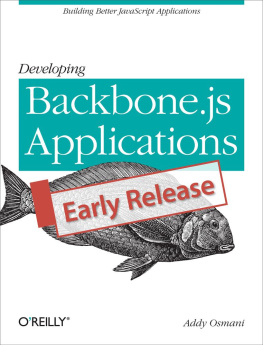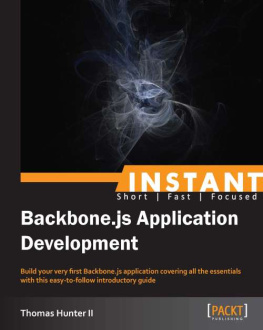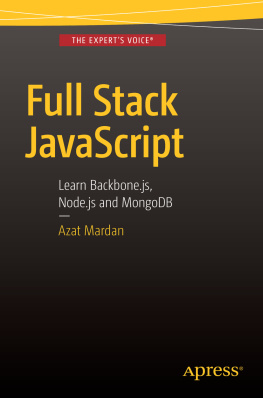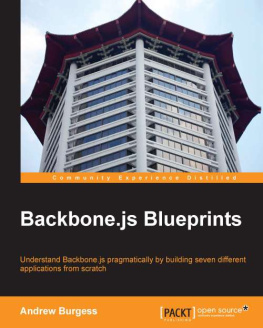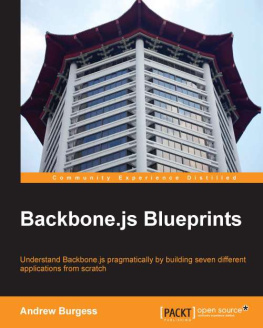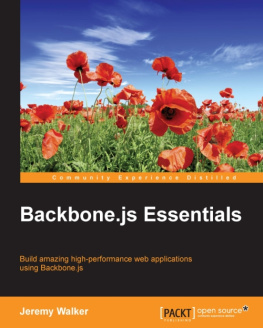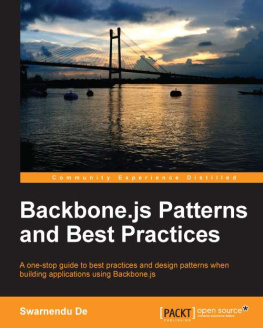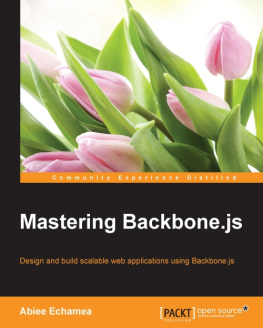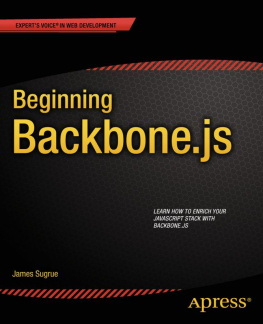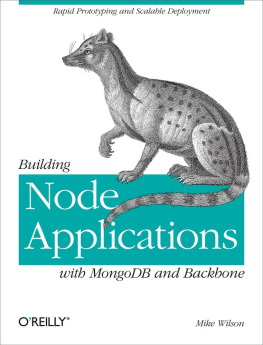Full Stack Web Development with Backbone.js
Patrick Mulder
Preface
Web users demand intuitive and responsive interfaces for tracking their finances and browsing catalogs. Unlike desktop or system applications, where interfaces are mostly built with flavors of C, C++, or Java, todays web browsers only run JavaScript natively. But the same patterns that make graphical user interfaces successful on different platforms apply to JavaScript as well.
Many communities have formed around experimenting and developing ideas for the model-view-controller (MVC) pattern with JavaScript. It seems like every day there is a new idea about how MVC in web browsers should look and why other ideas wont work for you.
In these turbulent times, the Backbone.js library stands out like a lighthouse. Unlike other approaches to JavaScript MVC, Backbone.js is very small and flexible. However, the main difference of Backbone.js compared to its peers is the Backbone ecosystem. Backbones philosophy of staying small gave birth to many plug-ins and a multitude of different, and some unique, use cases.
This rich ecosystem makes learning and understanding Backbone hard. If you are new to JavaScript, or if you have only built server-side web applications, you are faced with a number of problems. How do you combine views and the data layer with JavaScript? How do you abstract away JavaScript dependencies, such as Backbone plug-ins? How do you best serve and deploy JavaScript assets? But also, where is the controller in Backbone, or when are they used?
Answering these questions is one goal of this book. But Backbone.js really starts to shine when you learn to explore and engage with its rich ecosystem. First, there are many plug-ins for Backbone.js that can help you solve advanced UI problems. Second, build tools can help you to be more productive and also enable you to reuse ideas on both the client and server. This is my second goal: I want to show how a full-stack JavaScript application with Backbone.js can be built with the help of JavaScript modules, workflow automation, and the use Backbone plug-ins. For the backend, you will learn about basic API design ideas as well as perspectives on authentication.
Maybe you will be intimated by the variety of tools that you can use to develop Backbone.js web applications. The Backbone.js ecosystem is quite large, so not all choices of tools will work for you. However, I hope this book will help you to decide which tools will work best for the particular app you are working on.
If your JavaScript programming skills are a bit rusty, entering client-side application development can be a daunting adventure. I hope to provide a sort of basecamp from where you can explore different directions to build interactions within browsers and help you to understand the benefits of separating interface from application state.
In summary, well cover:
- How to quickly get started with a Backbone.js sandbox
- How to manage data and state with Backbone.js models and collections
- How to work with advanced view templates and Handlebars
- How to use Backbone.js to browse data sources from an API
- How to authenticate and authorize client-side interactions
- How to improve productivity of a team with workflow automation and Backbone frameworks
Who This Book Is For
This book is written for readers coming from one of these backgrounds:
- You are a backend developer with some experience in rendering web pages on the server. You are maybe impressed by the fast feedback from browser applications, or you want to build advanced browser interfaces for navigating and editing data in the browser.
- You are a frontend developer with interests in single-page web applications or interactive widgets in web browsers. You maybe found jQuery not meeting your goals anymore and are looking to learn what Backbone.js is about.
- You are a product manager or team lead that is responsible for making technology choices. If you want to understand where Backbone.js and JavaScript fit in your technolgoy stack, this book is for you.
Building single-page web applications involves more than just questions around interfaces, so this book also discusses basics of JavaScript modules, build approaches, and API backends. When scanning the table of contents this book, you might discover that JavaScript offers a number of interesting options.
Hopefully this book can show paths to structure web applications in a new way, toward friendlier and more scalable web applications. This book will be especially interesting to developers who want to learn approaches for using a user interfaces as a service, where frontend and backend services can be maintained and deployed independently.
Who This Book Is Not For
With Backbone.js, you have a lot of freedom to control interactions with documents based on JavaScript. The scope of the book is not avoiding JavaScript in the first place.
Other frameworks to build interactive documents such as Angular.js or Ember provide more abstractions and a high amount of sugar to build interfaces. However, the philosophy of this book is to pull in abstractions and dependencies when needed, and not start with those in the first place. This book should provide Backbones viewpoint on when and why certain abstractions are useful.
Related to maintainable and scalable application design is testing. Testing JavaScript applications with, for example, Jasmine or command-line tools is discussed in other specialized books and will be mentioned where appropriate.
Although the ideas from Backbone.js have quickly diffused into very interesting realms, such as highly interactive maps, system applications, browser extension, and hybrid applications for mobile phones, it is not possible to discuss all of these.
You will work mainly with the browser, a text editor, and the command line. If you prefer integrated development environments (IDEs), any one with support for JavaScript will do, such as Webstorms from Jetbrains or a version of Visual Studio with Node plug-ins. Also, Netbeans and Eclipse should support basic web development with JavaScript and HTML.
If you are on a Windows machine that does not support a Unix command line, you might want to install Cygwin or a virtual machine (VM) running Unix so that you can better follow along with the examples.
What This Book Will Do for You
The first goal of this book is to help you understand the different use cases of Backbone.js. Since its first release in 2010, Backbone.js has built up a good reputation for improving the development of client-side web applications. There are a number of interesting projects and companies that use Backbone.js. For example, Walmart uses Backbone.js as the core library of its mobile shopping cart. Airbnb uses Backbone.js to let users and search engines browse available travel accomodations. DocumentCloud has built a document screening service with Backbone.js. There are many more examples, and you can find an interesting overview in the Examples section of the Backbone.js documentation.
Second, this book should help you climb the learning curve for getting things done on the client side. Many books target JavaScript frontend developers and leave out those having built server-side web applications. Other books stop the discussion when Backbone.js can be put to practical use in real applications.
Hopefully this book can provide a bridge from client-side to server-side concepts and help you understand the advantages of the Backbone ecosystem. You can then adopt a mind-set for JavaScript applications in general, on the client or in combination with server-side JavaScript.

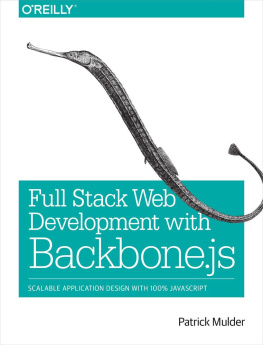
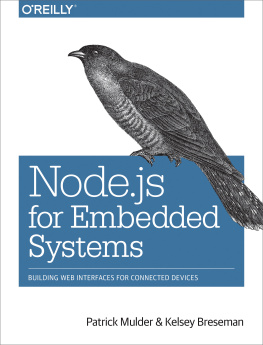
![RachelLeach - Developing Backbone.js applications: [building better JavaScript applications]](/uploads/posts/book/229199/thumbs/rachelleach-developing-backbone-js-applications.jpg)
